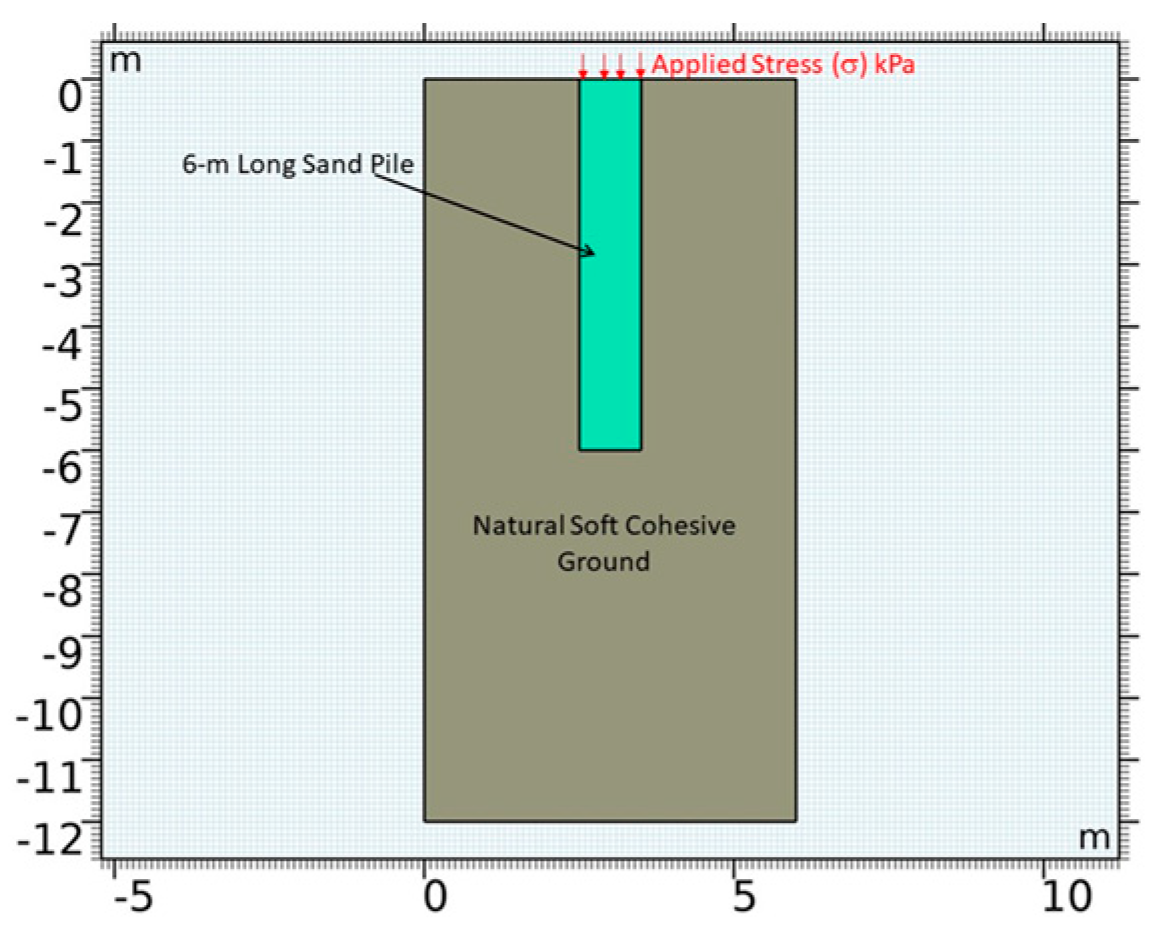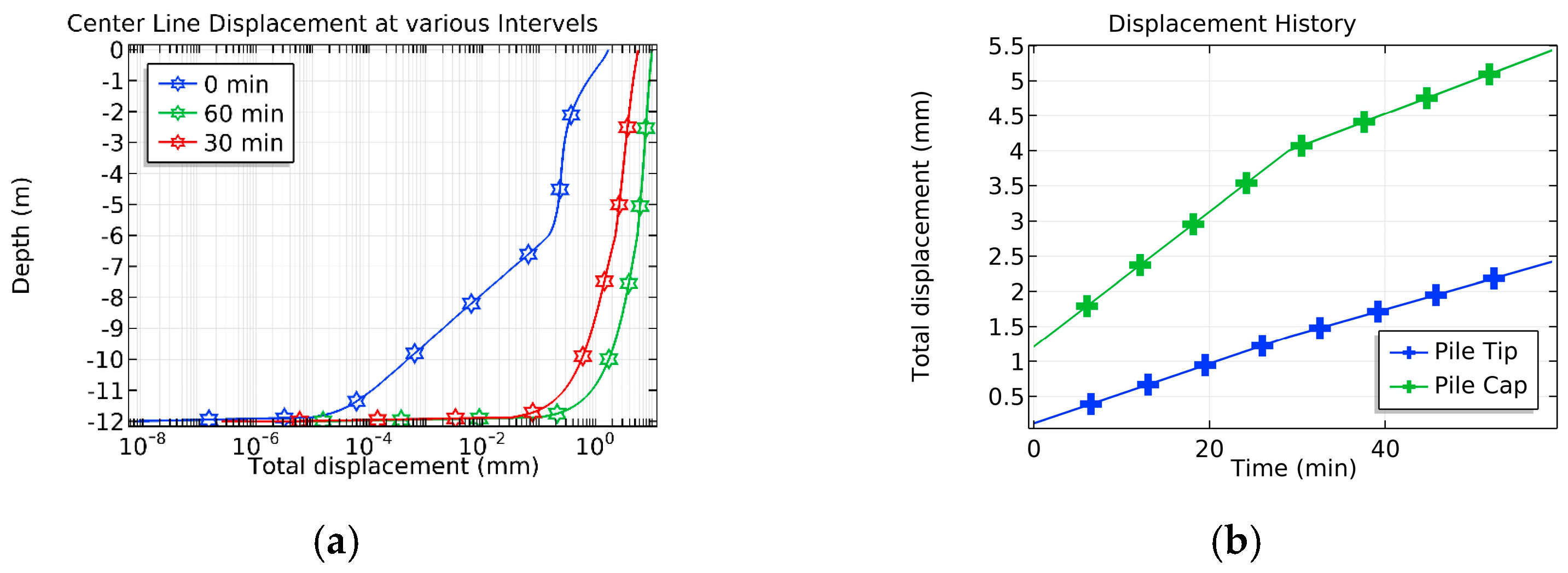Effectiveness of Mono Sand Piles in Soft Cohesive Ground †
Abstract
:1. Introduction
2. Materials and Methods
3. Results and Discussion
4. Conclusions
- Numerical simulations can be economically used to predict the mechanical behavior of complex soil systems such as sand piles in soft cohesive ground.
- The sand pile, a stiffer material, can bear most of the imposed stresses while reflecting low strain values, resulting in overall low settlements of the foundation system.
- The time-dependent or consolidation behavior of the foundation remains a challenge in cohesive ground even after the installation of the sand pile.
Author Contributions
Funding
Institutional Review Board Statement
Informed Consent Statement
Data Availability Statement
Conflicts of Interest
References
- Naqash, M.T.; Farooq, Q.U. Performance of Rigid Steel Frames under Adequate Soil Conditions Using Seismic Code Provisions. Open J. Civ. Eng. 2018, 8, 91–101. [Google Scholar] [CrossRef]
- Kementzetzidis, E.; Pisanò, F.; Elkadi, A.S.K.; Tsouvalas, A.; Metrikine, A.V. Gentle Driving of Piles (GDP) at a sandy site combining axial and torsional vibrations: Part II—cyclic/dynamic lateral loading tests. Ocean Eng. 2023, 270, 113452. [Google Scholar] [CrossRef]
- Hussein, M. Effect of Sand and Sand-Lime Piles on the Behavior of Expansive Clay Soil. Adv. Civ. Eng. 2021, 2021, 4927078. [Google Scholar] [CrossRef]
- Harireche, O.; Naqash, M.T.; Farooq, Q.U. A full numerical model for the installation analysis of suction caissons in sand. Ocean Eng. 2021, 234, 109173. [Google Scholar] [CrossRef]
- Chen, Z.; Wang, B.; Wang, C.; Wang, Y.; Xiao, P.; Li, K. Performance of a Subgrade-Embankment-Seawall System Reinforced by Drainage PCC Piles and Ordinary Piles Subjected to Lateral Spreading. Geofluids 2023, 2023, 4489478. [Google Scholar] [CrossRef]
- Farooq, Q.U.; Naqash, M.T. Performance of Shallow Building Foundations under Infrequent Rainfall Patterns at Al-Madinah, Saudi Arabia. Open Civ. Eng. J. 2021, 15, 91–103. [Google Scholar] [CrossRef]
- Al-Ramthan, A.Q.O.; Aubeny, C.P. Numerical Investigation of the Performance of Caissons in Cohesive Soils under Cyclic Loading. Int. J. Geomech. 2020, 20, 04020042. [Google Scholar] [CrossRef]




| System Component | Unit Weight (ϒ) kN/m3 | Soil Friction Angle (Φ) | Soil Cohesion (C) kPa | Elastic Modulus (E) MPa | Poisson’s Ratio (n) |
|---|---|---|---|---|---|
| Natural Ground | 14.71 | - | 50 | 40 | 0.3 |
| Sand Pile | 19.60 | 32 | - | 75 | 0.25 |
Disclaimer/Publisher’s Note: The statements, opinions and data contained in all publications are solely those of the individual author(s) and contributor(s) and not of MDPI and/or the editor(s). MDPI and/or the editor(s) disclaim responsibility for any injury to people or property resulting from any ideas, methods, instructions or products referred to in the content. |
© 2023 by the authors. Licensee MDPI, Basel, Switzerland. This article is an open access article distributed under the terms and conditions of the Creative Commons Attribution (CC BY) license (https://creativecommons.org/licenses/by/4.0/).
Share and Cite
Farooq, Q.U.; Naqash, M.T. Effectiveness of Mono Sand Piles in Soft Cohesive Ground. Eng. Proc. 2023, 44, 3. https://doi.org/10.3390/engproc2023044003
Farooq QU, Naqash MT. Effectiveness of Mono Sand Piles in Soft Cohesive Ground. Engineering Proceedings. 2023; 44(1):3. https://doi.org/10.3390/engproc2023044003
Chicago/Turabian StyleFarooq, Qazi Umar, and Muhammad Tayyab Naqash. 2023. "Effectiveness of Mono Sand Piles in Soft Cohesive Ground" Engineering Proceedings 44, no. 1: 3. https://doi.org/10.3390/engproc2023044003
APA StyleFarooq, Q. U., & Naqash, M. T. (2023). Effectiveness of Mono Sand Piles in Soft Cohesive Ground. Engineering Proceedings, 44(1), 3. https://doi.org/10.3390/engproc2023044003








